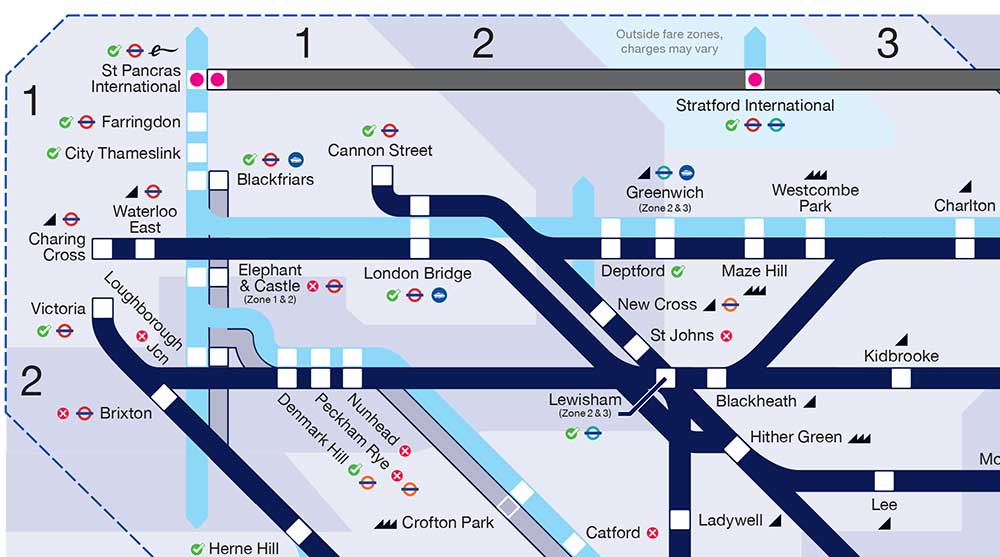Lewisham railway upgrades
Track and signalling upgrades in the Lewisham area.
With more than half of all Southeastern train services passing through Lewisham, unfortunately if there’s a track or signalling issue there, the knock-on effect can be very disruptive.
Trains can sometimes ‘stack’ up behind each other as they wait their turn to pass signals or junctions at cautionary speeds. This leads to delays and valuable time lost, just as it would if you were having to crawl along a main road at reduced speed limits due to an incident. Our job is to get you where you need to be, safely and on time. So, addressing the issues in the Lewisham area is critical for us. That’s why we’ve been investing a quarter of a billion pounds in the track and signalling there and will continue to do so.
The completion of some key projects and our closer-than-ever partnership with Southeastern means things are moving in the right direction. But before we get onto that, it’s worth explaining what the ‘Lewisham area’ is.
The ‘Lewisham area’

As the map illustrates, the Lewisham area covers a larger stretch of railway than just Lewisham itself. It’s not just the immediate surroundings of Lewisham station – it stretches as far out as: Nunhead, Ladywell, Hither Green, Blackheath, St Johns, New Cross.
So, when you hear a train driver or platform announcement refer to delays to services due to issues in the ‘Lewisham area’ now you know. The root cause of the delay might actually be taking place somewhere like Nunhead or New Cross. Not all faults occur immediately next to Lewisham station.
The Lewisham area is one of the busiest in terms of signalling due to the sheer number of trains that run through. We might spend a week upgrading the track or signals on one specific stretch of the line. At the same time, the infrastructure might have issues at the other side of ‘Lewisham’. The railway is large and complex and requires us to constantly monitor, maintain and upgrade the infrastructure.
What is the underlying problem?
Most of the current track and signalling systems in the Lewisham area were originally designed and installed in the 1960s and 1970s, which means this infrastructure is more prone to faults because of its age. Since then, passenger growth has soared and so, to meet demand, more trains are using the railway than ever before. This means the railway in this area suffers more wear and tear and needs more regular maintenance and repairs to keep passengers on the move.
Although it may not seem like it sometimes, infrastructure faults in the area are actually decreasing – 30% down on last year – however the delays caused by each incident are rising. That’s because it’s one of the most congested parts of the UK’s railway. Over half of Southeastern’s 1,600 daily train services pass through Lewisham on their way into London.
With the rail network almost at capacity, even the smallest incident can affect a huge number of trains and knock-on delays can quickly spread. Our main challenge is stopping the build-up of delays and restoring a punctual service as quickly as possible.
That’s why if an incident happens during peak travel times, we often decide to keep trains running rather than stopping them completely to fix the problem. Instead, we come back late at night to avoid more disruption during the busier parts of the day
How have we improved the Lewisham area recently and what’s to come?
We measure our performance and punctuality by the number of station stops made within 59 seconds of their booked schedule, this is called On Time. Over the last twelve months we have delivered 4.6 million station stops On Time out of a total of just under 6.5M.
In 2019 and through 2020 we replaced the Hither Green signalling systems that dated from the 1970s with more reliable, modern kit.
In 2020 we replaced two key rail junctions; one at Parks Bridge and the other in St Johns. This involved replacing 2.5km of track and laying 7,500 tonnes of ballast and 1460 sleepers as well as a number of signalling points.
We also installed remote condition monitoring equipment on our most critical infrastructure to alert us and allow teams to fix potential problems before they occur – we’re very glad to say that 100% of the Lewisham points are now monitored.
In 2021 we upgraded the switches and crossings (moveable sections of track that guide trains from one track to another and allow them to cross paths) between St Johns / Lewisham to Grove Park and along the Sidcup line over the festive season.
We returned to the Lewisham area for nine days over the 2022 Christmas and New year period when we closed the Bexleyheath line (including Lewisham station itself) to renew the track and improve train service reliability.
We know all this work can be disruptive and that’s why we give as much notice so you can make alternative travel arrangements where possible. We also know it is vital to carry out these important upgrades.
We are determined to improve the railway. We can’t promise an end to you hearing the phrase the ‘Lewisham area’ on your train or at your local station, but we are confident you will start to hear it less often in the years ahead as our work comes to fruition.
Sign-up for email updates
Sign-up with your email address to receive updates on the South East upgrade and information on projects taking place across the Southern region.
Our privacy notice applies to the personal information that Network Rail collects about you, or that you provide to us. It explains how and why we use your personal information, who we disclose it to and how we protect your privacy.
Contact us
For more information, visit out South East Upgrade page, call our National Helpline on 03457 11 41 41 or contact us on Twitter @NetworkRailSE.